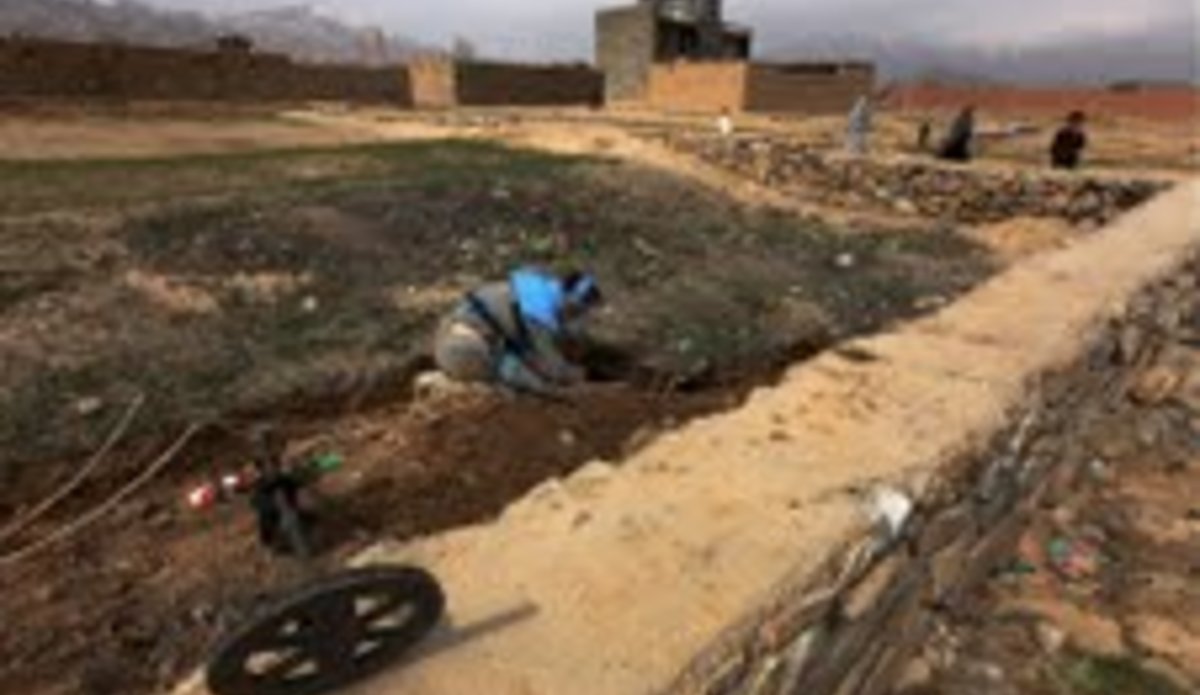Freeing communities from the threat of landmines
Mine risk education programmes help to educate Afghans, especially children and women, about the threats of mines and unexploded ordinance
KABUL - Shafiqa Zurmati, a mine risk education (MRE) trainer, distributes pictures of explosives to neighbourhood children ranging in age from four to 15 sitting cross-legged in her Kabul apartment. Pictures and posters of various mines and explosives hang on her walls.
Nearly three-quarters of the 375 Afghans killed or injured in 2011 by mines and other explosive remnants of war were children, often out in unknowingly dangerous areas collecting firewood and scrap metal, according to the United Nations project Mine Action Coordination Centre (MACCA).
“Mines and other explosives can take our lives. I have learned now what they are, and I can recognize a dangerous place. I know if there are red and blue stones, the area is contaminated,” said one of the students, 12-year-old Shazia.
Shafiqa works for OMAR, an Afghan demining agency that is an implementing partner for the Mine Action Programme of Afghanistan (MAPA) linked to MACCA.
She and her colleagues hold education classes in locations where people at risk are likely to gather, such as schools and UN Refugee Agency (UNHCR) encashment centres for returning refugees.
“When they come back, they are usually less familiar with mines and other explosives [than other Afghans], but they return to villages that are heavily contaminated.”
“Many people know what a mine and explosive ordnance is, but they have never seen what they actually look like. So I show them samples at the encashment centre, and create an environment where they have the feeling of being in a real minefield.”
Despite long-running clearance operations, the threat of mines is still real in Afghanistan. Approximately nine per cent of severely disabled Afghans have injuries from mines and unexploded ordinance.
Mine clearance is painstakingly slow work. At an average rate of seven meters per day, it takes a demining team of 10 people three months to clear an area the size of 100 square meters. Each metal piece has to be investigated, even if it is simply a button.
Before the first snow in Kabul, a team of 30 professional and trained community deminers, along with mine detecting dogs, finished clearing a 99,100 square meter neighbourhood in Darulaman. Twenty-year-old explosive items there lay dormant until construction on 150 houses began in 2009.
“This is where the first anti-tank mine was detected during house construction,” said Abdul Ghafoor, pointing to a large black rock near a row of small white and red painted rocks delineating the cleared from the potentially dangerous spaces.
Ghafoor is an Operations Officer with Afghan Technical Consultants (ATC), a non-governmental organization implementing the project managed by UN Mine Action Service (UNMAS), and coordinated by MACCA and the Afghan Department of Mine Clearance.
In addition to four anti-tank mines, deminers also found six anti-personal mines, 679 different unexploded ordinance and more than 250,000 fragments of metal.
“This is very important work. Before my training, I did not fully understand the dangers of mines,” said Khalil Rahman, a Darulaman resident and now trained community deminer.
The work in Darulaman is part of a two-year Kabul City Clearance Project (KCCP) designed to clear 2,340,700 square meters in its first phase in the capital and the suburbs.
Aside from the physical dangers of mines and unexploded ordinance, the hazards prevent Afghans from using their land – to build homes as in Darulaman, to farm or graze animals, or even to walk to school.
Despite the efforts to train people about the dangers of mines and unexploded ordinance, some Afghans oppose MRE classes.
“They don’t consider them to be important. Sometimes men don’t allow their women to attend classes. And some families are very poor, and don’t think MRE is critical. We try to convince them that it is,” Shafiqa said.
She said that she hopes the country will eventually be free of threats: “Mines and unexploded ordnance have damaged our society; we don’t want to have victims anymore.”
By UNAMA Kabul
Mine Action Programme of Afghanistan (MAPA) Fast Facts
Threat: 6,216 hazardous areas, affecting 602 sq. km and 1,980 communities.
Casualties: 375 instances of Afghans killed or injured in 2011; 75 per cent children
Progress: Since the start of the programme 20 years ago, more than 17,129 areas cleared.
Goal: The Ottawa Mine Ban Convention requires total clearance of all anti personnel minefields by 2013. So far, 52 per cent in terms of area and 44.5 per cent of hazards are cleared.
New hazardous areas continue to be found in Afghanistan, increasing the challenge of the goals set by the Ottawa Treaty.
Mine Risk Education (MRE): More than 284,221 people educated in second half of 2011; 43 per cent female.
 UN
UN







